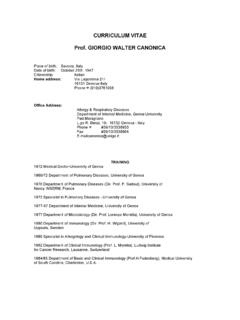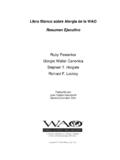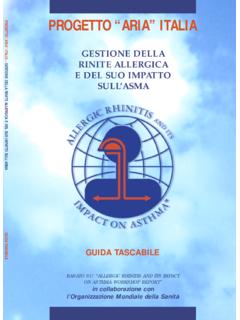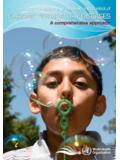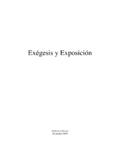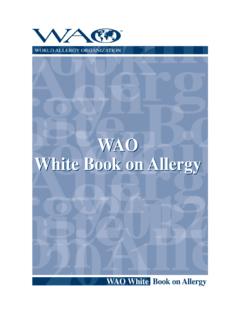Transcription of EAACI/GA LEN/EDF/WAO guideline: management of urticaria
1 Position paperEAACI/GA2 LEN/EDF/WAO guideline: management of urticariaThis guideline is the result of a panel discussion duringthe Third International Meeting on urticaria ,Urticaria2008, a joint initiative of the EAACI DermatologySection, GA2 LEN, EDF, and is a heterogeneous group of diseases thatresult from a large variety of underlying causes, areelicited by a great diversity of factors, and presentclinically in a highly variable way. The aim of treatment,This guideline, together with its sister guideline on the classification of urticaria (Zuberbier T, Asero R, Bindslev-Jensen C, Canonica GW, Church MK,Gime nez-Arnau AM et al. EAACI/GA2 LEN/EDF/WAO Guideline: definition,classification and diagnosis of urticaria . Allergy 2009;64: 1417 1426), is theresult of a consensus reached during a panel discussion at the Third Interna-tional Consensus Meeting on urticaria , urticaria 2008, a joint initiative of theDermatology Section of the European Academy of Allergology and ClinicalImmunology (EAACI), the EU-funded network of excellence, the Global Al-lergy and Asthma European Network (GA2 LEN), the European DermatologyForum (EDF) and the World Allergy Organization (WAO).
2 As members of thepanel, the authors had prepared their suggestions regarding management ofurticaria before the meeting. The draft of the guideline took into account allavailable evidence in the literature (including Medline and Embase searches andhand searches of abstracts at international allergy congresses in 2004 2008) andwas based on the existing consensus reports of the first and the second symposiain 2000 and 2004. These suggestions were then discussed in detail among thepanel members and with the over 200 international specialists of the meeting toachieve a consensus using a simple voting system where appropriate. Urticariahas a profound impact on the quality of life and effective treatment is, therefore,required. The recommended first line treatment is new generation, nonsedatingH1-antihistamines. If standard dosing is not effective, increasing the dosage up tofour-fold is recommended. For patients who do not respond to a four-foldincrease in dosage of nonsedating H1-antihistamines, it is recommended thatsecond-line therapies should be added to the antihistamine treatment.
3 In thechoice of second-line treatment, both their costs and risk/benefit profiles aremost important to consider. Corticosteroids are not recommended for long-termtreatment due to their unavoidable severe adverse effects. This guideline wasacknowledged and accepted by the European Union of Medical Specialists(UEMS).T. Zuberbier1, R. Asero2, C. Bindslev-Jensen3, G. Walter Canonica4,M. K. Church1, A. M. Gim nez-Arnau5,C. E. H. Grattan6, A. Kapp7,M. Maurer1, H. F. Merk8, B. Rogala9,S. Saini10, M. S nchez-Borges11,P. Schmid-Grendelmeier12,H. Sch nemann13, P. Staubach14,G. A. Vena15, B. Wedi71 Department of Dermatology and Allergy, Charit Universit tsmedizin Berlin, Berlin, Germany;2 Ambulatorio di Allergologia, Clinica San Carlo,Paderno Dugnano (MI), Italy;3 Allergy Centre,Department of Dermatology, Odense UniversityHospital, Odense Area, Denmark;4 Allergy andRespiratory Diseases, DIMI University of Genoa,Genoa, Italy;5 Department of Dermatology, Hospitaldel Mar, IMAS, Universitat Aut noma of Barcelona,Barcelona, Spain;6 Dermatology Centre, Norfolk &Norwich University Hospital, Norwich, UK;7 Department of Dermatology and Allergology,Hannover Medical University, Hannover, Germany;8 Department of Dermatology, University HospitalRWTH Aachen, Aachen, Germany;9 ClinicalDepartment of Internal Diseases, Allergology andClinical Immunology, Medical University of Silesia,Katowice, Poland;10 Department of Medicine, JohnsHopkins University, Baltimore, MD, USA.
4 11 Allergyand Immunology Department, Centro Medico-Docente La Trinidad, Caracas, Venezuela;12 AllergyUnit, Department of Dermatology, UniversityHospital, Zurich, Switzerland;13 Department ofClinical Epidemiology & Biostatistics, Hamilton,Canada;14 Department of Dermatology, JohannesGutenberg-University Mainz, Mainz, Germany;15 Unit of Dermatology, University of Bari, Bari, ItalyKey words: consensus; guideline; treatment; urticaria ; ZuberbierCharit Universit tsmedizin BerlinAllergie-Centrum-Charit Charit platz 1D-10117 BerlinGermanyAccepted for publication 3 July 2009 Allergy 2009: 64: 1427 1443 2009 John Wiley & Sons A/SDOI: , is the same for all types of urticaria : to achievecomplete symptom relief. The management of urticaria isbest subdivided into two basic lines of approach both ofwhich should be considered in each patient: first, theidentification and elimination of the underlying cause(s)and/or eliciting trigger(s), and, second, treatment aimedat providing symptom the cause is the most desirable option, but itis, unfortunately, not applicable in the majority ofpatients, especially in cases of inducible urticarias whichare mainly idiopathic.
5 Second best is avoidance of theeliciting trigger or stimulus, which can be instituted forthe rare patients with IgE-mediated urticaria and partly,for those patients with physical urticaria . In the lattergroup, the impact of physical stimuli can be diminishedand symptoms ameliorated by appropriate measures ( ,cushioning in pressure urticaria ). In spontaneous acuteand chronic urticaria , treatment of associated infectiousand/or inflammatory processes, includingHelicobacterpylori-associated gastritis, parasitic diseases, or food anddrug intolerance may be helpful in selected cases. Inaddition, it must be noted that some factors, ,analgesic drugs, can elicit new wheal formation as wellas augment preexisting urticaria . Chronic urticaria is alsorecognized as stress vulnerable disease in whichpsychological stress can trigger or increase itching. It issuggested that effective management process could takeinto account, at least in some of the patients, psycholog-ical factors (2 4).
6 In all cases symptomatic relief shouldbe offered while searching for treatment is currently the most frequentlyused form of management . It aims ameliorating orsuppressing symptoms by inhibiting the release and/orthe effect of mast cell mediators and possibly otherinflammatory treatment options available have been evaluated inthis guideline according to the following members of the panel, the authors had prepared their sugges-tions regarding management of urticaria before the meeting. Thedraft of the guideline took into account all available evidence in theliterature (including Medline and Embase searches and hand sear-ches of abstracts at international allergy congresses in 2004 2008)and was based on the existing consensus reports of the first andsecond symposia in 2000 and 2004 (5, 6). These suggestions werethen discussed in detail among the panel members and with theparticipants of the meeting, to achieve a consensus using a simplevoting system where appropriate.
7 The participation of more than200 specialists in urticaria from 33 countries ensured that thisconsensus included European and global regional differences inviewpoint and provided a basis for improved comparison of futurestudies in the field of the previous consensus document, studies were evaluated usingthe Methodology Checklist 2 for Randomized Controlled Trials(RCTs) of the Scottish Intercollegiate guidelines Network (SIGN)resulting in the following 3-level code: ++, +,). This code,together with the study type, decided the Level of Evidence (1++to 1), 2++ to 2), 3, 4) that led to the Grade of Recommendation(A D). However, the SIGN methodology does not assign a qualityor level of evidence for the body of evidence and it is intended onlyfor assessment of individual studies that are identified during thesearch process. However, in order to express the confidence in thetotality of evidence an approach to assessing a body of evidence fora given questions is required.
8 For the current guideline we used apragmatic Grading of Recommendations Assessment, Develop-ment, and Evaluation (GRADE) approach transforming the al-ready existing evaluations of the literature according to the SIGN criteria for individual studies from the previous guideline andadding newly published studies (Table 1). We based our ratings onthe levels of evidence we obtained using the SIGN methodologyfrom the previous guidelines without re-examining the key principle of the GRADE approach is to provide trans-parency and clear and explicit criteria for assessing the quality ofevidence and grading the strength of recommendations (7 11).While recommendations in guidelines , in particular those developedTable 1. Evidence of identified literature sourcesThe level of evidence provided by the study is derived from the code allocated forthe methodological quality and the type of study, according to the MethodologyChecklist 2: Randomized Controlled Trials of the Scottish IntercollegiateGuidelines Network (SIGN).
9 1++High quality meta-analyses, systematic reviews of RCTs, orRCTs with a very low risk of bias1+Well conducted meta-analyses, systematic reviews of RCTs,or RCTs with a low risk of bias1)Meta-analyses, systematic reviews of RCTs, or RCTs with ahigh risk of bias2++High-quality systematic reviews of case controlled orcohort or studiesHigh quality case controlled or cohort studies with a verylow risk of confounding, bias, or chance and a highprobability that the relationship is causal2+Well conducted case controlled or cohort studies with alow risk of confounding, bias, or chance and a moderateprobability that the relationship is causal2)Case controlled or cohort studies with a high risk ofconfounding, bias, or chance and a significant risk thatthe relationship is not causal3 Nonanalytic studies, , case reports, case series4 Expert opinionSIGN level of evidenceGRADE Quality of evidence1++High1+Moderate1)Low2++Low2+Lo w2)Very low3 Very low4 Very lowAbbreviations used in this and subsequent tables: AH, antihistamine; ns, nonse-dating; RCT, randomized controlled trial; s, sedating, sg, second following translation to the GRADE quality of evidence was used acknowledgingthat a more detailed assessment will possibly change the quality of evidence andthat additional quality criteria are considered in et 2009 John Wiley & Sons A/SAllergy 2009: 64: 1427 1443with the GRADE approach, should ideally be based on well donesystematic reviews, a more pragmatic approach to applyingGRADE includes the identification of well done systematic reviewsfor a given clinical question or, alternatively, conducting a system-atic review.
10 An even more pragmatic approach includes the use ofinformal summaries based on searches of the literature. This shouldbe followed by grading the quality of evidence and strength of eachrecommendation. The key principle is to be transparent about themethods, in particular those that are used for summarizing theevidence and the key factors influencing a this urticaria guideline 2008 update most of the sections didnot follow systematic review methodology, but we did follow thegeneral principles of GRADE for assessing the quality of evidenceand strength of recommendations. Factors that influence thestrength of a GRADE recommendation are the quality of theunderlying evidence, the balance between desirable and undesirableeffects and resources used for an of the strength of a recommendation from the qualityof supporting evidence is critical when making GRADE system permits strong recommendations supported bylow or very rarely very low quality evidence from downgraded RCTsor observational studies.


